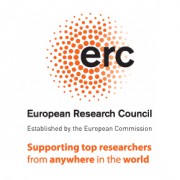Blog
Buchelius’ Utrecht Republic of Letters
By Dirk van Miert, Jan Fongers, Anne Haak, Erell Smith, Tirreg Verburg and Chantal van der Zanden
Some collections of manuscripts are only used because of bits of information they contain. But how can one analyse a cahier with copies of scholarly letters as a self-contained unit? That was the question that we, five students and a teacher, asked ourselves in the MA-course ‘Skills in Renaissance Studies’. By way of experiment, we sought the answer not in the contents of the letters, but in the complete picture of the data about the letters: the names of authors and recipients, the place of writing, the address, and the date. With these five metadata it is possible to conduct two types of network analysis: a social and a geographical one. To gain this overall picture, however, we first had to collect all those metadata.
Manuscript no. 983
Our source was manuscript no. 983 in Utrecht University Library. In a 19th-c. catalogue, this manuscript is described as Epistolae diversorum descriptae ex authographis ab Arnoldo Buchelio et Arnoldi Buchelii ad diversos, or: “Letters from various people, copied from the autographs, by Arnoldus Buchelius and [letters] from Arnoldus Buchelius to various people”. From this description one can gather that the collection not only contains copies of letters to and from the Utrecht antiquarian Buchelius (Aernout van Buchel, 1565-1641), but also from other scholars who populate the international intellectual world known at the time as the ‘Republic of Letters’. Indeed: Buchelius did copy out letters from others, even from people long dead before he was born, as for example letters from pope Adrian VI to the Churches of Utrecht. But why these particular letters? What was Buchelius’ purpose? What was his criterion of selection?
To find out the answer, we divided this book of apographs into six sections – one for each of us to take care of. We were aided by the table of contents drawn up in the 19th century in the printed manuscript catalogue of P. A. Tiele, although it turned out that this overview is far from complete. Yet, it contains more information than the national digital catalogue, the Catalogus Epistolarum Neerlandicarum (CEN: “Catalogus of letters kept in collections in The Netherlands” – a database that merits to be better known).
Numbers
The CEN yields 81 hits for ms. 983, but some of these hits cover more than one letter, although it is not always clear how many letters. Moreover, the manuscript also contains mere fragments of letters – the texts are incomplete, but the metadata are all there. This suffices for the purpose of network analysis, although these fragments are not listed in Tiele’s catalogue (probably because the letters are incomplete). Apart from the five core metadata, we also listed the language of the letter, and the folio numbers of the manuscript where the letters appear.
In total, it appeared that ms. 983 contains the metadata of 207 letters, written between 1515 and 1640, although most letters date from the period 1590-1640:
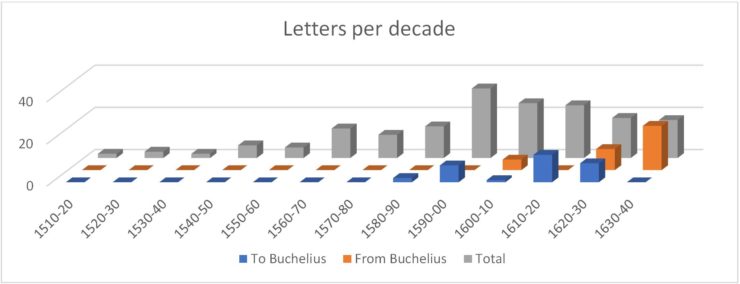
Geograhical visualisation
We entered these data into Nodegoat, a visualisation tool that is specifically designed for network analyses, used frequently by historians. A static geographical visualisation of all these metadata looks like this:
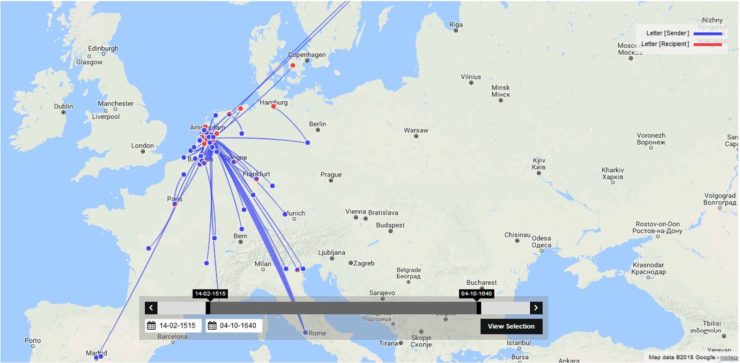
The correspondence ranges from Madrid in the south of Europe to Uppsala (just off the screen) in the north. What is striking is that the network is concentrated in the Low Countries, but that there is also intensive contact with Rome. When we zoom in, we see the following:
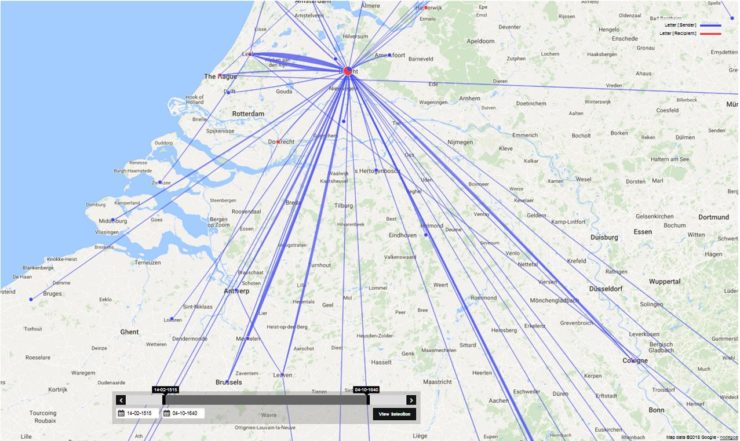
Utrecht is quite clearly the centre of this collection of letters. Three quarters of all the letters in the manuscript were addressed to Utrecht, which lead us to suspect that Buchelius, who lived in Utrecht and gathered a great deal of historical information about Utrecht, primarily selected those letters for transcription which he encountered in this city. It can also mean that he came across letters elsewhere, but that he chose to copy out only those letters which were addressed to people living in Utrecht, or (less frequently) written by Utrechters. So here we notice in one birds’ eye view the visualisation of an important criterion: Buchelius was apparently interested primarily in Utrecht correspondences. It is also clear that many letters bear witness to contact with Leiden, where Buchelius’ brother-in-law Everard Vorstius was appointed professor in 1598. But there is also contact with Catholic centres: we already mentioned Rome, but Cologne, Louvain, Brussels and Antwerp are also focal points.
The time slider allows one to trace the geographical development of the netwerk through time. This can be done in a cumulative way, which visualises the constant adding of more data, but one can also a move a window through the dataset: for example a time slice of 5 or 10 years. We invite you to play with the dataset yourself (if the visualisation is not visible, please use another browser):
Social network analysis
Next to the geographical visualisation, Nodegoat allows to draw social network visualisations. This renders the following picture:
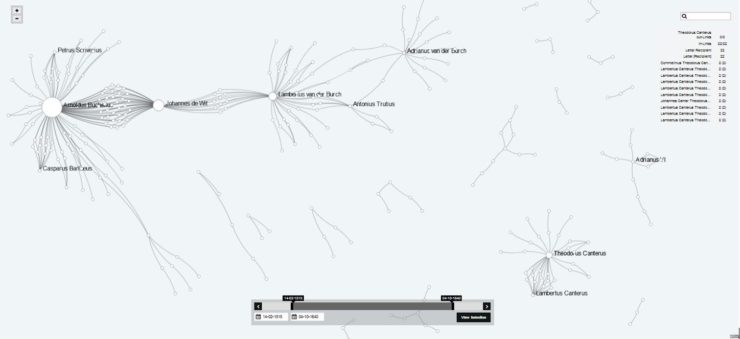
On the left, there is a large white ‘node’ that stands for Buchelius himself. He has frequent contact with the antiquarian and philologist Petrus Scriverius and with the philosopher-poet Caspar Barlaeus, but above all with one Johannes de Wit. The latter moved to Rome in 1612, which largely explains the intensive contact with Rome (Johannes de Wit is not the famous statesman Johan de Witt). It is noteworthy that we only have one side of the correspondence: only the incoming letters of De Wit to Buchelius (and of these not whole copies, but only synopses of their contents). Apparently, Buchelius at the time did not draw up copies of his outgoing mail, or he stored these somewhere else. De Wit himself maintained quite a bit of contact with the canon Lambertus van der Burch, and the latter in turn with his brother, the scribe Adrianus van der Burch. Buchelius appears not to have had direct contact with Lambertus van der Burch, but was one handshake removed from him. However, we need to be cautious: Buchelius and Van der Burch both lived in Utrecht and might well have been friendly neighbours, with no need to correspond through letters. It does appear that it was via De Wit that Buchelius came into contact with the noble family Van der Burch, who allowed him access to ecclesiastical (Lambertus) and governmental (Adrianus) archives.
Furthermore, we notice on the visualisation a few ‘loose constellations’, for example Adrian VI (far right) or the Canter family (below, a bit to the left). These too, we know, were from Utrecht, but throughout the generations, there is no link with Buchelius to be found. Here, however, we also must not jump to conclusions: perhaps Buchelius did write letters to an older person who himself had corresponded with the Canters. What is clear, is that Buchelius was very interested in the Canter family. This was probably not only due to the fact that Theodorus (Dirk) Canter had been burgomaster (mayor) of Utrecht, but also because Canter and his elderly brother Willem were philologists of high standing. It was precisely in this humanist philological tradition that Buchelius displayed an increasing interest. The link with the canon Johannes de Wit and with the south is likewise explained through Buchelius’ own interests: with De Wit he searched for antiquarian remains in and around Utrecht. He also visited Antwerp and Brussels to study the interior and exterior of old buildings and to expand his collection of antiquities with new drawings, finds and purchases.
Here, too, we can zoom in on the networks or move through the dataset with a time slider. If we do the latter with a time slice of five years, we first see small networks jumping in and out of sight. These include a number of interactions of Adrianus van der Burch, whom see in the top middle, as part of the larger network. He, too, drops in and out of vision, so his network is scattered over different periods (as far as the data in ms. 983 are concerned, of course). See the interactive visualisation (if the visualisation is not visible, please use another browser):
Buchelius’ network
It is important to keep in mind that what we are looking at is not the epistolary network of Buchelius himself, but an image of the metadata of the letters he collected. This means that only part of these data visualise part of Buchelius’ epistolary contacts.
While Buchelius’ gradually expands his network, that of Adrianus van der Burch disappears completely. This is no miracle, because he died in 1606. When Johannes de Wit drops off the radar, we see other, more familiar, names coming into view: Barlaeus for example, but also Gerard Vossius, Anna Maria van Schurman, Jacob Cats and Daniel Heinsius. Buchelius at the time appears to have climbed upward to the higher layers of the Republic of Letters. Then we approach the year 1640, in which Buchelius died. As far as the visualisation can be limited to the period of Buchelius’ life, we can see that Buchelius at first still had frequent contact with Catholic friends, but that he starts to correspond more and more with Reformed people. This process of conversion has been masterfully described by Judith Pollmann in Religious Choice in the Dutch Republic: The Reformation of Arnold Buchelius (1565-1641) (Manchester, 1999). The social visualisation neatly confirms her conclusions.
‘Every period has its customs’
An important aspect of Buchelius is his interest in the material history of religion. Buchelius was deeply impressed by the dismantling of Catholic real estate, even if he contributed to this process in some ways. He maintained contact with people who were likewise interested in history and through whom he could gain access to relevant material. In a letter to Samuel Ampzing from 1630, Buchelius criticizes historians who fail to acknowledge the idiosyncrasy of the past. All too often they describe the past from their own contemporary point of view: ‘Every period has its customs, its ceremonies, even its destinies. And its own handwriting, script, and style of writing. If you are blind for these distinctions, you cannot avoid cloaking the truth in darkness’ (cited after Sandra Langereis, Geschiedenis als ambacht (Hilversum, 2001), p. 68). Buchelius might just have wanted to outdrive these historians by assembling his own version of the history of Utrecht – a history focussed on the impact of the Reformation on local cultural and scholarly traditions. Further indications for such a project about the recent history of the Utrecht Republic of Letters are found in the other papers of Buchelius.
Relation with other manuscripts
A manuscript like 983 should be considered in relation to the other material that Buchelius collected and that is exploited by Utrecht University Library. In some other collections we encounter the original autographs of some of the copies found in ms. 983. Many of the letters he collected refer to antiquities that crop up in other papers of Buchelius. The conclusion must be that this visualisation of metadata provides us with an overview, but that this is insufficient for forceful conclusions: therefore, we really have to regard the texts. But these visualisations do manage to teach us in one angelic view that Buchelius not just randomly collected letters of famous people in this cahier: he was consistently concerned with the life and work of Utrechters and the learned history of Utrecht.
Work to be done
The extensive Buchelius-collections were already the subject of an inventory by Cornelis Booth in the 17th century, and are currently being digitized step by step. Kees Smit has already transcribed the letters from Van Gouthoeven to Buchelius and had them digitized. If we also describe the remaining Buchelius-manuscripts in detail, the visualisation will tell us a great deal more about the preferences of those who were responsible for creating these collections.
In the next blog, you can read more about ms 985 and its relations with ms 983.
You must be logged in to post a comment.


